Wearable App Development: App Types, Business Opportunities
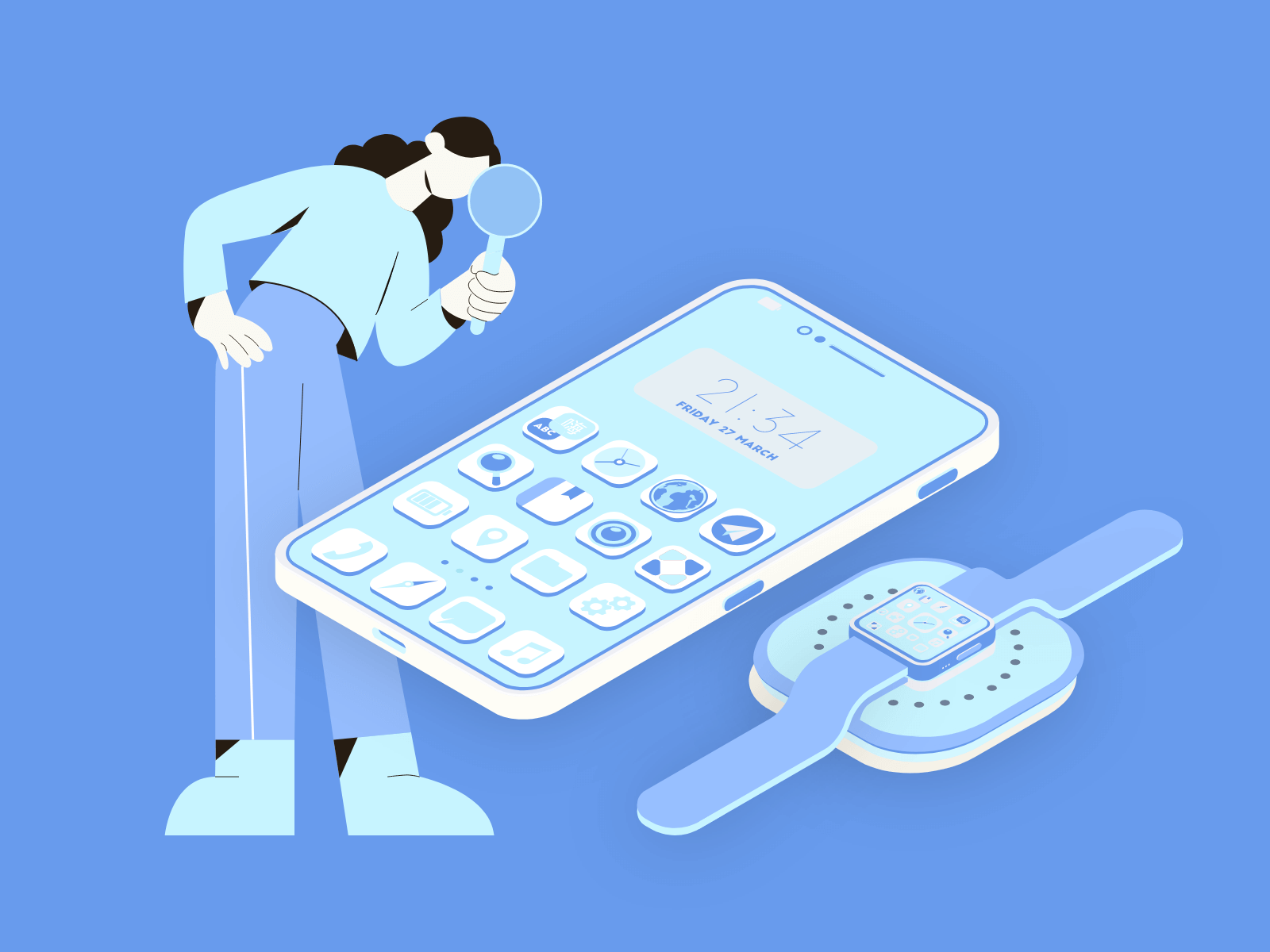
Smartphones and smart devices have emerged and penetrated dee into our everyday life, and one can hardly imagine a day without a smartphone, headphones, and smartwatches. It is true; we love the comfort and everything that makes our lives easier. No wonder why wearables market has registered a tremendous rise in past years. Smartwatches, wristbands, health monitors, and other solutions are projected to soar in the future.
The number of wearable connected devices has already surpassed one billion this year.
The technologies standing behind those wearables are no less exciting. If you want to integrate wearables into your existing application or simply get insights, it is high time to dive into the topic. The guide gives answers to all the questions you might have about the process of wearable application development.
Here is what you’ll learn in the article:
- The difference between apps for wearables and mobile
- Key wearable platforms
- The most successful wearable applications
- Why it is worth creating a wearable app & business benefits
- Industries benefiting from wearable apps
- Wearable app development step-by-step guide + architecture analysis
- Ways to avoid pitfalls of app development
Let’s dive right in!
What is Wearable App Development?
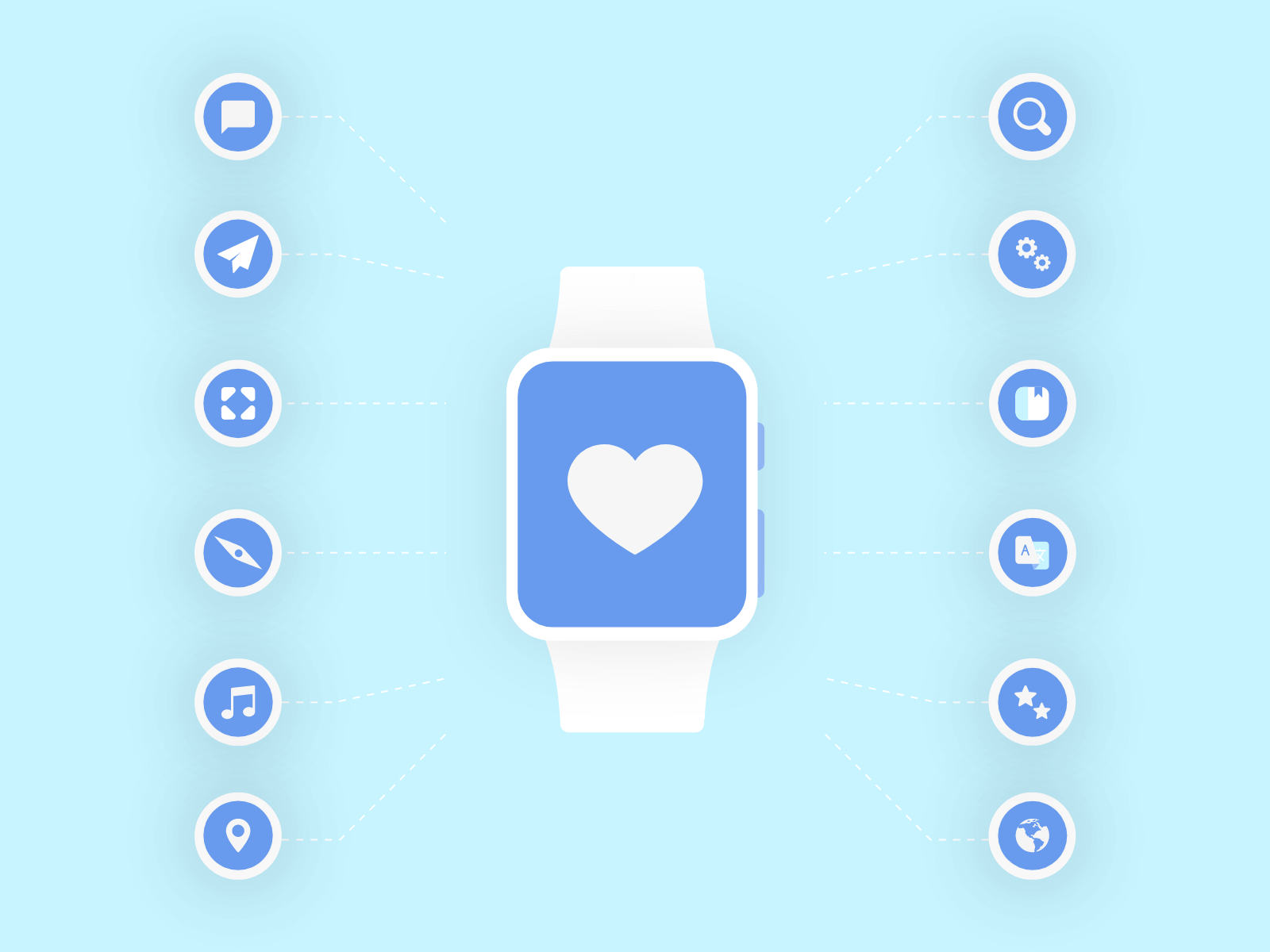
Before we talk about how to create a wearable app, let’s first answer an important question: What are wearables?
Wearables are devices that users wear on them like accessories or as a part of clothing. These gadgets usually connect to smartphones to exchange data between the network and the device.
Wearable applications are those that receive data from such wearable devices. Apps of this type have access to the device’s hardware and operation system. These sensors collect the data and transfer it to the app programmed for the desired outcome.
Today, the market of wearables is full of different solutions. Smartwatches, activity trackers, fitness bands, and even smart glasses have already taken a significant place in our everyday lives. Their popularity is projected to only grow in the upcoming years.
The Difference Between Wearable and Mobile Apps
While wearable apps might seem similar to mobile applications, there are a few differences that set them apart:
- Limited functionality as compared to mobile applications
- Fewer user interactions and inputs are required
- A lot of processes are happening in the background
- Wearable apps are not cross-platform as they are using device-specific APIs
Examples of Key Wearable Platforms
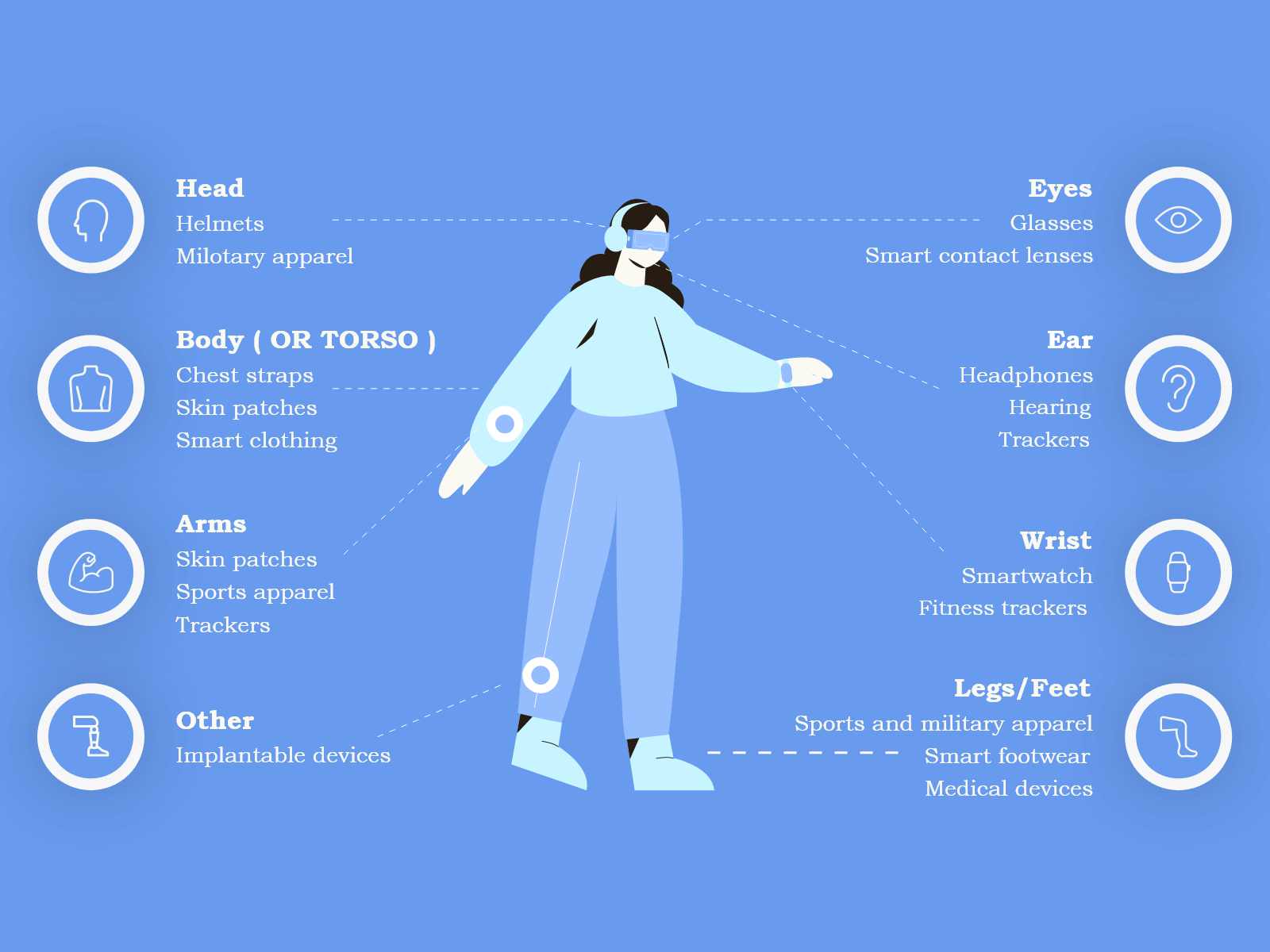
Let’s take a quick look at the most popular types of wearable devices today:
- Smartwatches – one of the most popular wearable devices in the world. Smartwatches eliminate the need to always keep a smartphone on you. Such devices undertake numerous tasks, such as sending and reading messages, showing notifications, setting up alarms, tracking physical activity, etc.
- Fitness trackers – devices are used for monitoring physical activity, for example, tracking the number of steps taken, calories burned, heart rate, sleep, and much more. Today, fitness trackers offer a part of the features supported by smartphones, such as displaying notifications.
- Head-mounted displays – VR glasses are the most explicit example of such devices. They can be used as monitors or provide users with AR (Augmented Reality) and VR (Virtual Reality) information.
- Smart jewelry - the most prominent example of smart jewelry is smart rings. These tiny devices track physical activity and collect information transferred to smartphones for further user interaction.
There are also other types of wearables that are less popular, such as smart clothing and implantable.
Wearables have critical importance for the healthcare industry. Glucose monitors help patients track their glucose levels. Different diagnostic trackers are used to identify muscle activity, body temperature, chronic diseases, and much more.
Explore the image below demonstrating what data wearable devices can collect when used in the healthcare industry.
Top-10 Wearable Applications
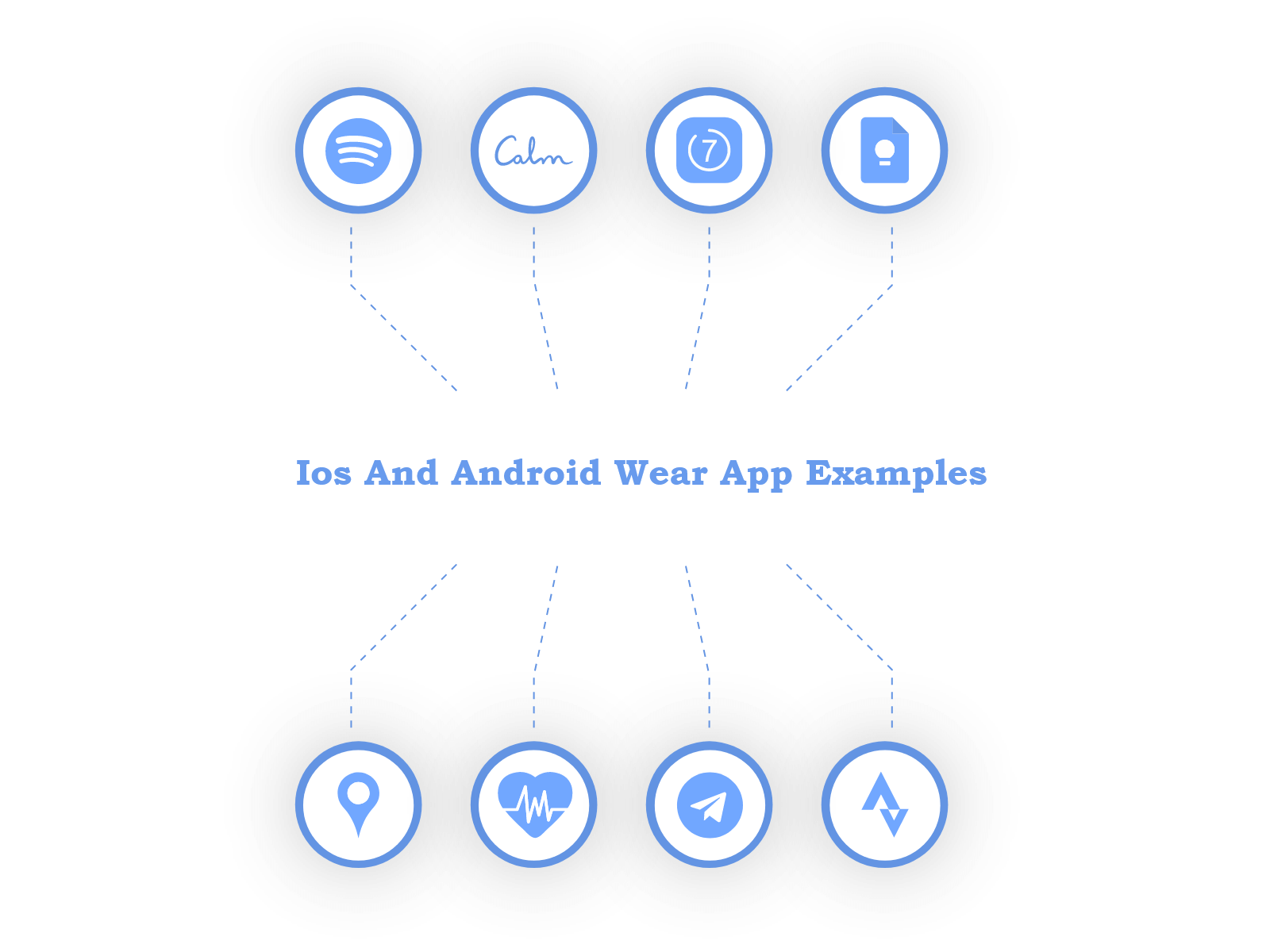
Wearable technology has already become an integral part of our lives. Wearable applications serve different purposes, such as helping users plan their days, track physical activity, monitor sleep, etc.
Here, you can find the ten most prominent examples of wearable apps with millions of users worldwide.
Let’s get some inspiration for your future application.
1. Calm
This application is designed to help users relax and have a better sleep. For this purpose, the solution provides calming music, images, and breathing exercises for meditation purposes.
Supported platforms: Android Wear, watchOS
2. Spotify
This popular music application has a version for wearable devices. Users can leave their smartphones at home, go for a walk or a jog and listen to their favorite music. The wearable version has many features, allowing to create playlists, share them with friends, find new music, and control it right from the wrist and their smartwatches.
Supported platforms: Android Wear, watchOS
3. 7 Minute Workout
This application is a lifesaver among users who don’t want to spend hours on workouts. 7 Minute Workout app offers 12 high-intensity exercises with calculated workout and rest periods. Users can work out at their homes and select an appropriate workout schedule tailored to their personal physical needs and capabilities.
Supported platforms: Android Wear, watchOS
4. Google Keep
Google Keep is available on different platforms, including wearables. This solution allows you to create notes on a smartwatch without pulling a smartphone from your pocket. Aside from notes, users can set up reminders, create shopping lists, organize notes by type, etc.
Supported platforms: Android Wear, watchOS
5. Uber
Uber also has a dedicated application for wearable devices. With the help of a smartwatch, users can book a cab, check the status, share their ride details and even call emergency services.
Supported platforms: Android Wear, watchOS
Wearable app development is no longer limited to creating a workout application. The list and app examples above clearly demonstrate that wearable applications can be used across various industries and serve various purposes.
6. Calculator
Taking a smartphone from your pocket just to use it as a calculator is frustrating. Thankfully, there is a wearable application that owners of smartwatches on Android Wear can use for the task. Aside from basic calculations, it can be used for scientific calculations (trigonometric, square root).
Supported platforms: Android Wear
7. Cardiogram
Cardiogram is a great example of a wearable app used for healthcare purposes. This solution, available for Android Wear and watchOS, tracks sleep, stress, fitness activities, and minute-to-minute heart rate. The application also shows possible reasons for any identified irregularities in a user’s heart rate.
Supported platforms: Android Wear, watchOS
8. Telegram
Free messaging solution also provides a wearable version of its application. Users can view their recent chats, react to messages with stickers, emojis, preset phrases, and locations, or even dictate answers with their voice despite somewhat limited functionality.
Supported platforms: Android Wear, watchOS
9. Strava
One of the most popular fitness applications both on mobiles and wearables. This solution tracks running and biking sessions. The app uses GPS and LTE to track the route so that users can leave their smartphones at home. With available features like tracking the riding speed, covered distance, elevation, and calories burned during activities.
Supported platforms: Android Wear, watchOS
10. Google Maps
The famous maps service is also available on wearable devices. The app can navigate users to desired locations, measure distance, offer alternative routes, and much more
Supported platforms: Android Wear, watchOS
This was only the tiny part of all available apps for wearables you may find now on Play Market and App Store.
The Most Promising Industries to Create Wearable App
Wearable app is not only trendy but beneficial for a brand to target the group of customers who actively use wearables and want to have functionality on wearable as well. Let’s review some of the industries that are already using wearable applications.
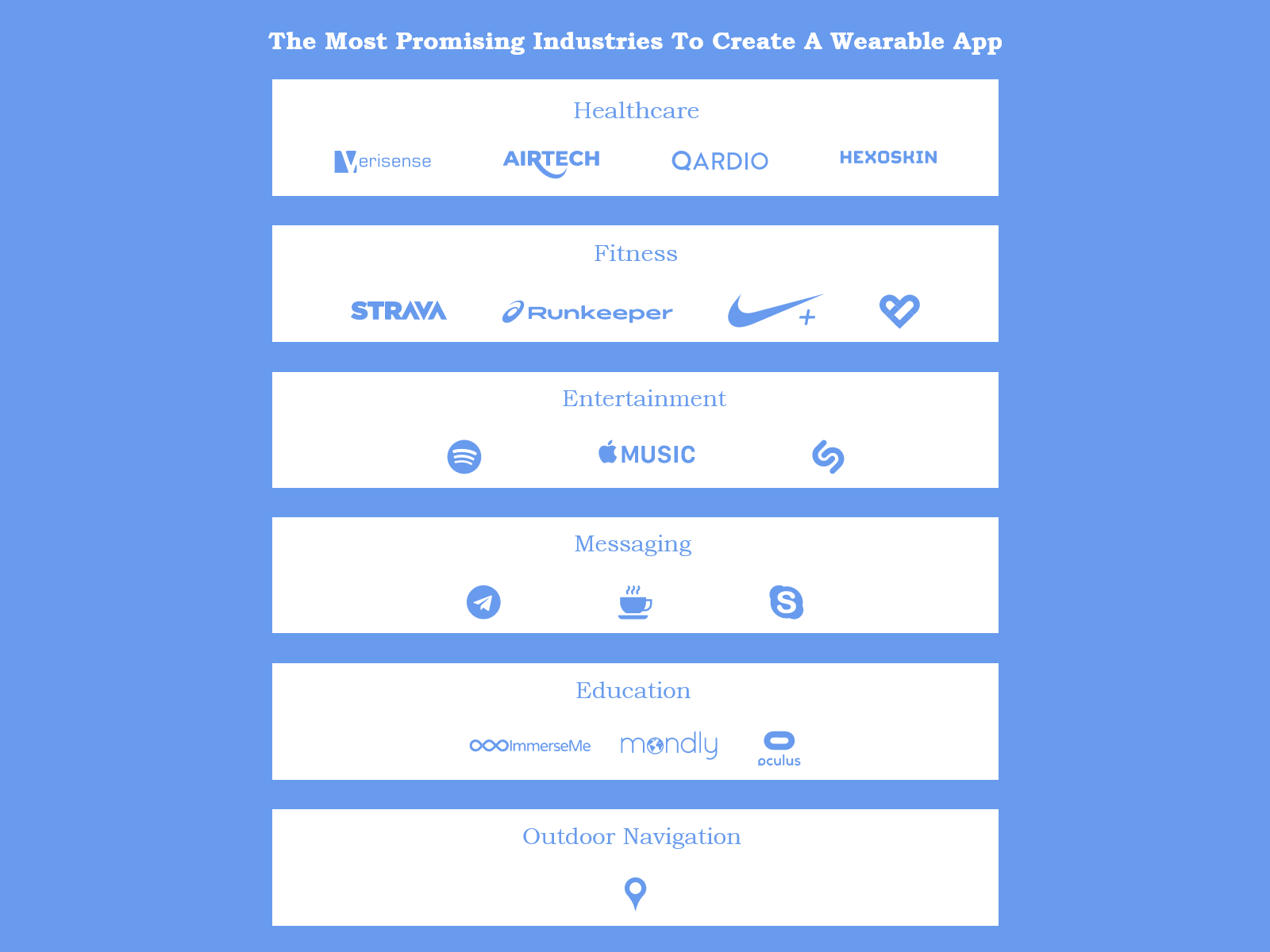
Healthcare
Wearable devices are a valuable asset for the healthcare industry. They help doctors to monitor the health of patients and diagnose diseases. Such devices use different sensors to collect health data, monitor heart rate, glucose levels, etc. The main goal of such applications is to improve the quality of healthcare services and timely diagnosis of even rare diseases.
Wearable devices for healthcare can be represented in different forms, including smart bands, glucose monitors, diagnostic chips, and cardiac monitors.
Examples: VeriSense, Aira Tech, Quardio, Hexoskin
Fitnes
Wearable applications are the most common on the market. Fitness applications allow users to track the state of their health and body. Smartwatches and fitness trackers provide the necessary tools to keep track of physical activity during workouts, jogging, and daily tasks, calculate calories, measure distance covered, and much more.
Examples: Strava, Runkeeper, Google Fit, Nike+
Outdoor Navigation
As a leading solution, Google Maps is compatible with all platforms and wearables. There is a lot of potential for such solutions since more and more smartwatches and fitness trackers are equipped with GPS, gyroscopes, and other technology. Thus, you can build outdoor navigation applications that are fully independent of smartphones.
Examples: Google Maps
Messaging
Thanks to smartwatches, leaving your home without a smartphone doesn’t seem impossible today. The availability of messaging applications makes them even more helpful since they can be fully functional, not connected to the phone.
Examples: Telegram, Coffee, Skype
Education
Wearable devices are not limited to smartphones. Such applications can be created for augmented and virtual reality glasses, such as Google Glass, and used in education. AR and VR allow students to explore the world, examine molecules in detail, and study diseases and the human body.
Examples: ImmerseMe, Ocean Rift, Mondly
Entertainment
Wearable devices are used for several reasons; one of them is to listen to music and podcasts while commuting, running, or working out. You can approach building the next Spotify for your smartwatch in different ways.
Examples: Spotify, Apple Music, Shazam
Insurance
The insurance industry is highly plugged by fraudulence. Insurance companies could benefit from wearable devices if they could get data from smartwatches and fitness trackers. In fact, such solutions already exist, like the cooperation between UnitedHealthcare, an insurance company, and Fitbit, a company behind a fitness tracker.
Examples: Attain,
Fintech
The banking system can also benefit from wearable technology. Today, smartwatches and fitness trackers are equipped with NFC sensors that enable contactless payments.
Examples: Apple Pay, Google Pay
How to Create Wearable App: Exhaustive Guide
Before starting with wearable app development, you need to take care of a number of tasks. The process is not limited to coding. You need to understand what type of application you want to create, different types of architectures, and how to choose a reliable app development company.
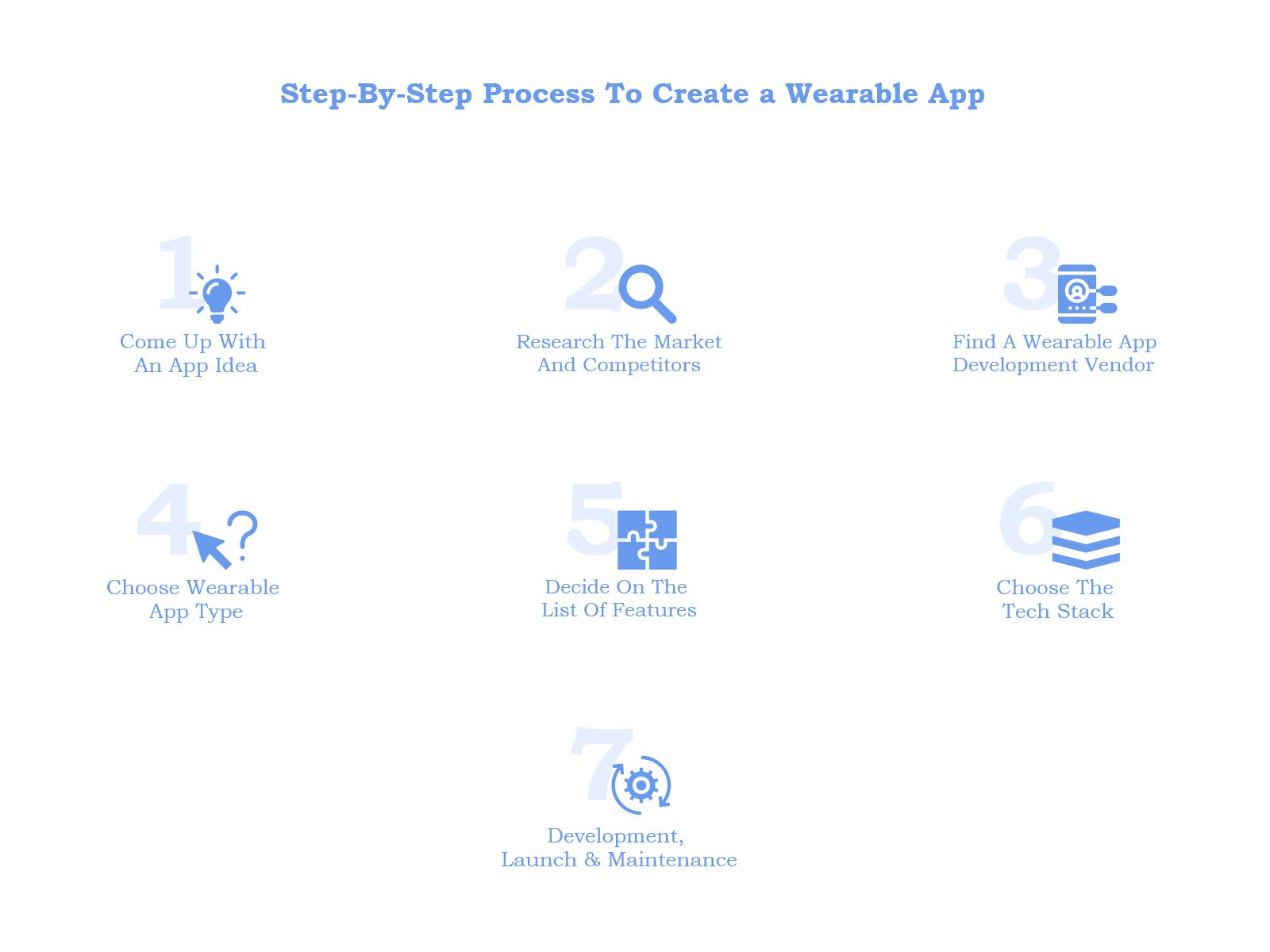
Here, you learn how to create a wearable app step by step.
Come Up with an App Idea
Creating an app is one thing but coming up with a brilliant idea for an app is a totally different thing. Actually, it is much harder to think of a value proposition with no identical one in the market. This stage requires tons of market research, development of buyer personas, competitor analysis, etc. Much depends on the results of this stage.
Identification of users’ needs will help you get started. Wearable applications are designed to make the life of users better and simpler. You need to understand how the availability of a wearable app version will help you do the job.
Pro Tip: If you are stuck finding an app idea, don’t give up! There are a lot of applications in the app marketplaces that can become your inspiration.
Research the Market and Competitors
Once you have found your niche, you can go for deeper market analysis. You can start by identifying what applications are popular in your target region and analyzing their strong and weak points. You will learn a lot about your competitors and come up with ways to provide a better solution that users will fall in love with.
After you have all the data, you can go on with a business model and project planning.
Find a Wearable App Development Vendor
Smart technologies require professionals with deep knowledge and expertise in relevant fields. With access to a global talent pool, you have all the chances to find a dream team. Depending on your budget, requirements, culture, and other criteria, you can find an offshore outsourcing company corresponding to your project requirements.
There are a few tips that you can utilize to find the best vendor for your project:
- Shortlist app development companies - start looking for a wearable development company. You can find vendors on directories like Clutch, ITFirms, GoodFirms, etc. They provide information on thousands of companies worldwide, allowing to filter companies by region, price tag, relevant experience, etc. Such platforms are a great place to shortlist the companies for the future.
- Identify the best prospects - you have probably found hundreds of companies that might seem great for your project. In fact, not all of them will do the job. Identify companies with a magic combination of relevant experience, great customer reviews, competitive price tag favorable location.
- Interview prospects - after you’ve successfully identified up to 10 vendors, carry out deeper research of shortlisted candidates, check previous collaborations and reviews, and finally, interviewing them personally.
- Make your choice - choose a company based on the communication approaches, location, pricing tag, and the availability of previous relevant experience.
Choose Wearable App Type
There are a few possible solutions you can build for a wearable device. They differ in how they operate, their independence from a mobile device, and their functionality. Let’s review some of them:
- Standalone app - it is a wearable application that runs on a wearable device itself and has a direct connection to the internet through Wi-Fi. Standalone apps are fully independent of mobile devices.
- Companion app - such wearable apps complement mobile applications. They have limited functionality and require regular or constant data exchange with a mobile application.
- Faces - this is not an app, but a custom lock screen created for a smartwatch.
- Glances - such cards contain the latest updates from mobile applications and are available to users at a glance.
- Notifications - such solutions are limited to only showing push notifications from smartphones on the screens of wearable applications.
In most cases, businesses develop companion and standalone applications for wearables. Such apps have a sufficient level of independence from mobile devices and can perform numerous tasks.
Wearable apps also differ when it comes to installation methods:
- They can be installed from a wearable apps store
- They can be installed from a smartphone
- Not installed, meaning an app on the phone sends information to the wearable
You need to understand what type of application you are going to create before you start the development. This way, you will avoid unnecessary re-doings and save time and money.
Decide on the List of Features
Let’s review some of the most common features used in wearable app development.
- Smartphone module
When we talk about wearable app development, in most cases, we talk about the development of two apps - one for a smartphone and one for a wearable. If you decide to create a standalone application, you will probably need to develop a so-called container app. Such an app carries out the setup process and app installation. However, most smartwatches can connect to the internet via Wi-Fi and get an app directly from a store.
You can also create a companion app for an already existing mobile application or simultaneously develop both the companion app and the mobile app.
- UX, UI, and controls
One obvious difference between mobile and wearable app development is screen size. Wearables have tiny screens that require micro-layouts. You can create a great user experience if only you provide the necessary information, limit the use of buttons to one per screen, and use short text.
Some devices, such as the Samsung Gear series, have a rotating bezel that can be used to navigate the menu. The digital crown performs a similar feature on Apple Watch. You need to understand which platforms you are targeting to make good use of them. This way, you will be able to avoid using unnecessary on-screen elements.
- Navigation
As mentioned before, you can use the basic navigation implemented by wearable manufacturers to create a great user experience. For example, most smartwatches have their own gestures for moving between screens with swipes, selecting an item with taps, etc. You don’t need to reinvent the wheel.
- Push notifications
Users keep wearables on them all the time. Such devices are a great opportunity to remind users about upcoming events, planned calls, or workout sessions. Push notifications are a must-have for wearable applications. Today, you can even show whole text messages through such notifications or a preview of an upcoming event.
- Voice commands
Some wearable devices have voice assistants, and you can integrate your app with them. For example, devices on Android Wear have an assistant by Google, and watchOS devices have Siri.
Integration with their API will allow you to add the support of voice commands to your wearable application. It’s a nice-to-have feature, especially for workout apps. They would allow users to set up timers while they are working out and control other application features.
There are a lot of other features that an app can have based on the specific needs of your solution.
Choose the Tech Stack
At this stage, you need to understand which platform is your target. Working with the development vendor will help you choose the right technology stack, APIs, SDKs, and other solutions needed.
Below is a table that shows information about languages and IDE used for wearable platforms.
| Platform | Language | IDE |
| Android Wear | Java or Kotlin | Android Studio |
| watchOS | Swift or Objective-C | Xcode |
| Google Glass | Java or cloud-based | Android Studio |
| Samsung Gear (Tizen) | C, C++, JavaScript | Tizen SDK |
Development, Launch & Maintenance
After determining the type of platform, you can move on to the development stage, the most extensive and time-consuming processes with the constant involvement of QA engineers testing and cleaning bugs.
When the app is ready for the first release, it is submitted to app marketplaces with a marketing campaign to promote it among the target audience.
However, the work doesn’t stop after you release an app. Development is an ongoing process, and you need to maintain your app, add new features, fix bugs, and ensure its security.
How to Avoid the Challenges of Wearable App Development
When you create a wearable app, you may face many challenges.
If you work with an experienced team of wearable app developers, they will know how to address any issue with an actionable plan. Here is a shortlist of possible problems while developing an app.
- Privacy and data security - whether you are developing a wearable or a mobile app, you will need to deal with data security and privacy. Each wearable platform has its requirements, and if you want to place your app in App Store by Apple, for example, you will need to meet all of them.
- Battery consumption - your solution should provide high performance and battery efficiency. If it drains the battery of a wearable device in an hour or two, users won’t use it. You need to remember that wearable solutions have very limited battery resources.
- Ergonomic UX - designing a wearable application is challenging because of the small screen size. It’s essential to create a user interface that will look great on a small screen and that users won’t have a problem interacting with.
- Customized notifications - small screens don’t allow to show long messages. That’s why you need to design all notifications for wearable platforms specifically. The use of one- or two-word messages is one of the possible approaches.
Wearable Application Development: Is it worth developing an app for wearables?
The use of wearable app development is predicted to grow in the future. It is an obvious advantage to keep the pace of modern technologies and take a market share with a valuable product.
Wearable applications can become a great addition to your mobile app to improve the user experience or a standalone solution with unique functionality.
Wearable App Development, Create Wearable App, lifestyle trackers, Wearable Apps, Smart Watch Application Development, Online-Conferencing, Online Meetups, App Prototyping, Create Wearable App, How to Start a Streaming Service, Restaurant App, Cloud Based App, Develop App, Mobile App, Virtual Assistant, Medicine Delivery, Messaging App, Reminder App, Mobile App, Chat App Development, Shopping App
Do You Have a Wearable App Idea?
Explore the frontier of technology for you app
Our Expertise Covers:
✅ Seamless integration with popular wearables
✅ Health and fitness tracking features
✅ Customizable and user-friendly wearable apps
FAQ
Wearable application development consists of several steps:
- Coming up with an app idea
- Market and competitors research
- Finding a wearable app development vendor
- Deciding on the list of features
- Choosing technology stack
- Development
- Launch and maintenance
If you need help with development, get in touch with us.
There are numerous places where you can find a development vendor. Such platforms as Clutch, The Manifest, ITFirms, TechReviewer, and others provide information about companies worldwide.
Today, there are a few types of wearable solutions that you can implement:
- standalone apps
- companion apps
- faces
- glances
Outsourcing app development has many benefits:
- access to the best talents
- working with experienced developers
- better time efficiency
- no need for team management
- no bureaucracy and associated costs
 How Much Does It Cost to Build a Messaging App?
How Much Does It Cost to Build a Messaging App?
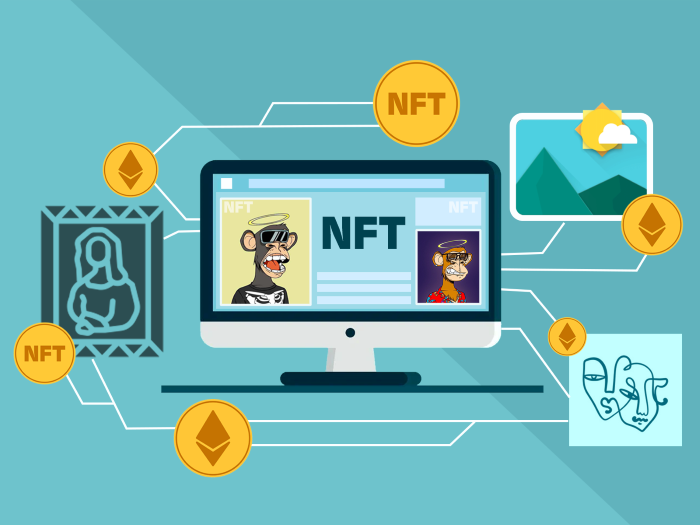 How to Create an NFT Marketplace: Development Guide
How to Create an NFT Marketplace: Development Guide
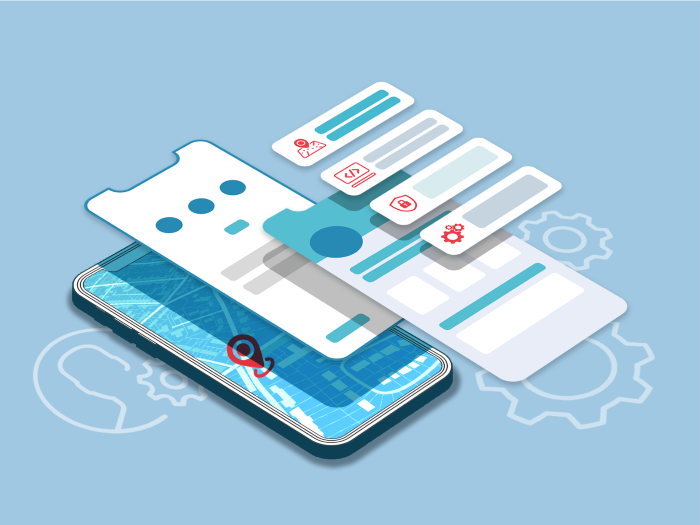 Must-Have Uber App Features: Building a Ridesharing App
Must-Have Uber App Features: Building a Ridesharing App